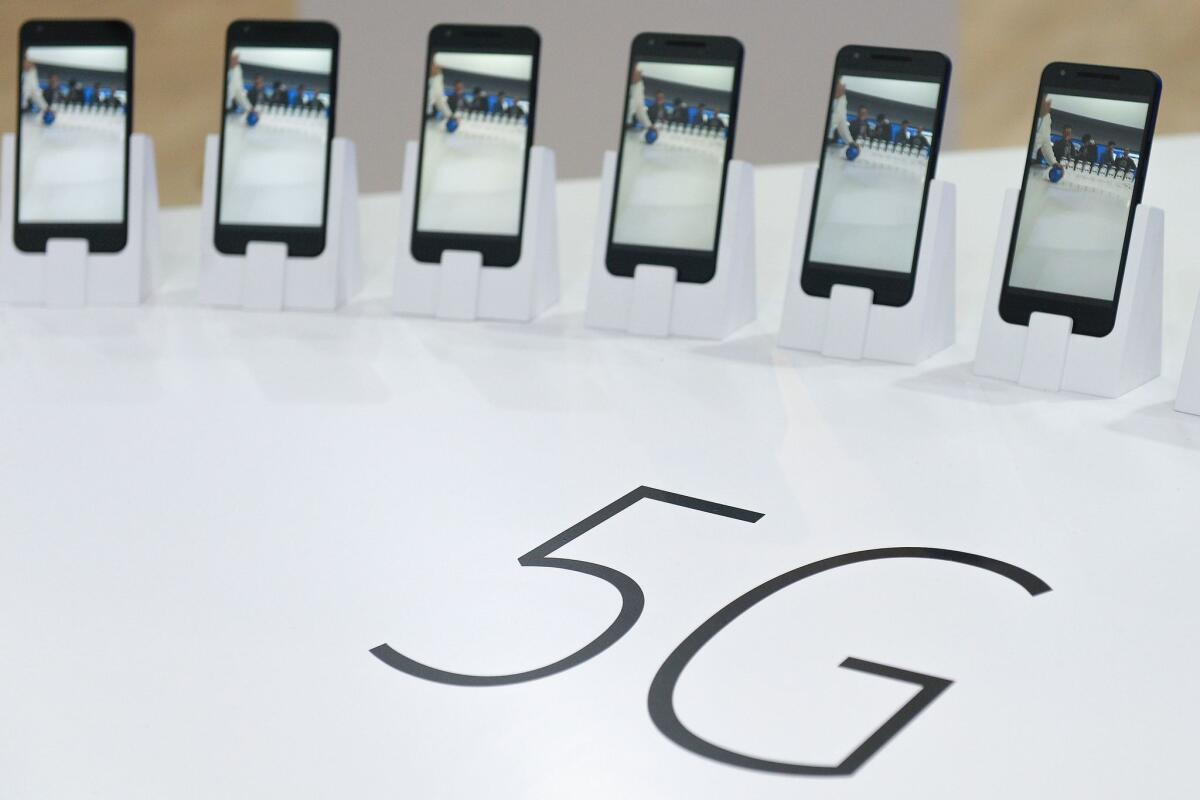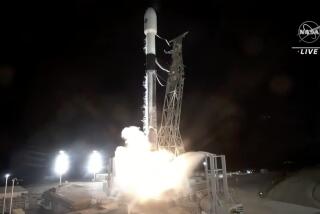FCC sets the stage for the next generation of wireless services: super-fast 5G

- Share via
Federal regulators on Thursday opened the door to the next generation of wireless services, making the U.S. the first nation to allocate a wide swath of airwaves to deliver super-fast 5G access.
The Federal Communications Commission voted unanimously to clear the way for mobile devices to send and receive signals over high-frequency spectrum that has had only limited uses until recent technological advances.
The agency also laid the groundwork to auction a large amount of that spectrum to wireless companies while allowing more open or shared uses of the rest – all with flexible rules in hopes of duplicating the regulatory environment that helped fuel innovation in the existing fourth-generation networks.
“By not getting involved in the technologies that will use the spectrum we’re turning loose the incredible innovators of this country … and with our oversight to protect competition we ensure that the forces that drive that innovation and improved consumer service are alive and well,” FCC Chairman Tom Wheeler said.
“This is a big day for our nation,” he said.
But the brave new world of 5G is still billions of dollars and several years away.
The FCC hasn’t set a date for an auction of licenses to use the new airwaves. And IGR, a wireless market strategy consulting firm, estimated it would cost $56 billion to develop, test and deploy technologies to use the spectrum in the U.S. through 2025.
The fifth generation of mobile service since the first bulky cellular phones were introduced in the early 1980s promises to deliver data at least 10 times faster than today’s 4G networks.
Experts said 5G is the key to expanded wireless uses, such as autonomous vehicles, Internet-connected appliances, virtual reality and yet-to-be-imagined applications. The technology also is seen as crucial to extending high-speed Internet access to rural areas that are expensive to serve with cable or fiber.
FCC Commissioner Mignon Clyburn said, “There is seemingly no limit on how what we refer to as 5G could impact our everyday existence.”
“A refrigerator that not only alerts you to a near empty egg carton, but automatically adds that item to a virtual shopping list, enabling a delivery to your door by week’s end, without any action from you,” she said. “Or remote surgery being performed in the Alaskan bush by a preeminent surgeon thousands of miles away.”
The airwaves set aside by the FCC previously had not been thought to be useful for commercial wireless services and have had limited uses, such as satellite transmissions.
But technological advances are making it possible to use that spectrum, which can carry large amounts of data much faster.
“We’re talking about a network that is 10 times faster than your current network and supports hundreds of times more devices,” said Meredith Attwell Baker, president of CTIA, a leading wireless trade group that pushed to open up the airwaves.
“It’s five times more responsive. It’s going to enable real-time services that are really going to unlock potential for consumers and the Internet of things,” she said.
Baker said that an autonomous vehicle using 4G technology takes 4.6 feet to stop once a signal is sent via a wireless connection. With 5G, the car would stop after travelling just an inch.
Still, there are limits.
The high-frequency airwaves can carry signals over shorter distances than 4G spectrum, so they require more receivers to knit together networks. But those receivers could be as small as smoke detectors, making them easier to deploy on existing towers and buildings.
The FCC has been trying to streamline the processes for approvals of those 5G base stations.
AT&T and Verizon are planning 5G trials next year, although the service probably won’t be available to most consumers until 2020.
But with South Korea, Japan and other nations studying the deployment of 5G networks, the FCC said the U.S. needed to act to maintain the nation’s technological edge in mobile technology.
“The race to 5G is on,” FCC Commissioner Jessica Rosenworcel said. “But for 5G technology to take off, for the United States to win this race, we need spectrum — and lots of it.”
Satellite companies are concerned about interference from new mobile uses in the high-frequency airwaves. And public interest groups want more of the airwaves to be available for unlicensed uses such as Wi-Fi instead of being auctioned to wireless companies.
The FCC said its new rules set up spectrum-sharing arrangements that would ensure satellite and mobile users could coexist.
But the satellite industry is concerned given the billions of dollars invested by SpaceX, OneWeb and other companies to develop networks to deliver high-speed Internet access.
“While we certainly believe that sharing is possible, we want to make sure there isn’t interference with existing and planned satellite operations,” said Tom Stroup, president of the Satellite Industry Assn., a trade group.
Follow @JimPuzzanghera on Twitter
UPDATES:
2:09 p.m.: This article was updated with details about the cost and timetable of deploying the technology.
This article originally was published at 9:00 a.m.
More to Read
Inside the business of entertainment
The Wide Shot brings you news, analysis and insights on everything from streaming wars to production — and what it all means for the future.
You may occasionally receive promotional content from the Los Angeles Times.











